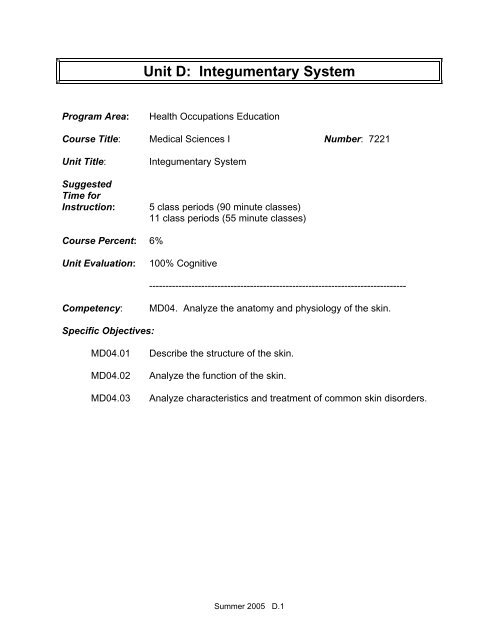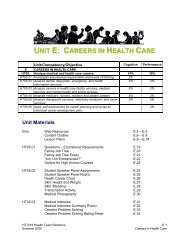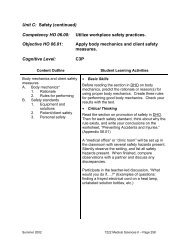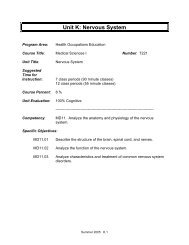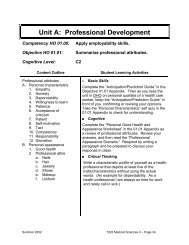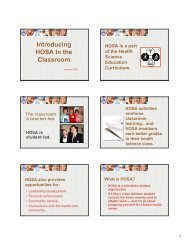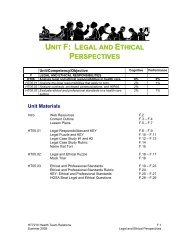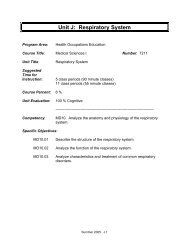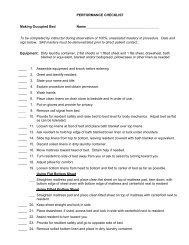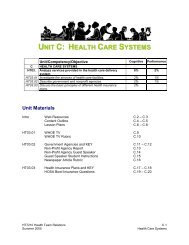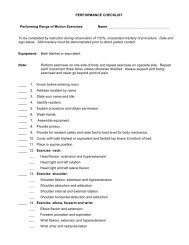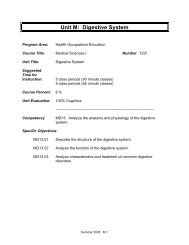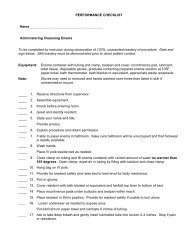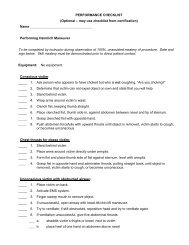Unit D: Integumentary System
Unit D: Integumentary System
Unit D: Integumentary System
You also want an ePaper? Increase the reach of your titles
YUMPU automatically turns print PDFs into web optimized ePapers that Google loves.
<strong>Unit</strong> D: <strong>Integumentary</strong> <strong>System</strong><br />
Program Area: Health Occupations Education<br />
Course Title: Medical Sciences I Number: 7221<br />
<strong>Unit</strong> Title: <strong>Integumentary</strong> <strong>System</strong><br />
Suggested<br />
Time for<br />
Instruction: 5 class periods (90 minute classes)<br />
11 class periods (55 minute classes)<br />
Course Percent: 6%<br />
<strong>Unit</strong> Evaluation: 100% Cognitive<br />
-------------------------------------------------------------------------------<br />
Competency: MD04. Analyze the anatomy and physiology of the skin.<br />
Specific Objectives:<br />
MD04.01 Describe the structure of the skin.<br />
MD04.02 Analyze the function of the skin.<br />
MD04.03 Analyze characteristics and treatment of common skin disorders.<br />
Summer 2005 D.1
D. <strong>Integumentary</strong> <strong>System</strong><br />
<strong>Unit</strong> D Master Outline<br />
MD04.01 Explain the structure of the integumentary system.<br />
A. Layers of the skin<br />
1. Epidermis – outer layer<br />
a. Stratum corneum<br />
i. Outermost of three epidermal layers<br />
ii. Contains keratin<br />
b. Stratum germinativum<br />
c. Melanocytes and melanin<br />
d. Papillae<br />
2. Dermis – inner layer<br />
a. Connective tissue<br />
b. Blood vessels<br />
c. Nerve endings<br />
d. Muscles<br />
e. Hair follicles<br />
f. Oil and sweat glands<br />
g. Fat cells<br />
3. Subcutaneous<br />
a. Adipose<br />
B. Appendages<br />
1. Hair<br />
a. Cortex and medulla<br />
b. Root and shaft<br />
c. Hair follicle<br />
d. Papilla<br />
e. Arrector pili muscle<br />
2. Nails<br />
a. Matrix<br />
b. Keratin<br />
3. Glands<br />
a. Sudoriferous glands<br />
i. Sweat = 99% water<br />
ii. Location<br />
iii. Pores<br />
iv. Activated by heat, pain, fever and nervousness<br />
b. Sebaceous glands<br />
i. Sebum – protects and lubricates skin<br />
MD04.02 Analyze the functions of the integumentary system.<br />
A. Skin<br />
1. Protection<br />
a. Intact skin best protection<br />
b. Skin generally too dry for microbial growth<br />
c. Most skin bacteria associated with hair follicles or sweat glands<br />
d. Best way to prevent spread of disease is handwashing<br />
2. Regulation of body temperature<br />
3. Manufactures vitamin D<br />
Summer 2005 D.2
4. Sensory perception<br />
5. Storage<br />
6. Sun screen<br />
7. Absorption<br />
B. Glands<br />
1. Sudoriferous glands (sweat glands)<br />
a. Perspiration is 99% water<br />
b. Distributed over the entire skin surface, large numbers under the<br />
arms, palms of hands, soles of feet and forehead<br />
c. Perspiration excreted through pores<br />
d. May be activated by heat, pain, fever and nervousness<br />
e. Underarm odor caused by bacteria mixed with sweat<br />
f. Ave fluid loss = 500 cc/day<br />
2. Sebaceous glands<br />
a. Sebum - oil<br />
b. Protects and lubricates skin<br />
MD04.03 Discuss characteristics and treatment of common skin disorders.<br />
A. Acne<br />
1. Disorder of sebaceous glands<br />
2. Sebum plugs pores and area fills with leukocytes<br />
3. Also, blackheads, cysts, pimples and scarring<br />
B. Albinism – absence of melanin<br />
C. Alopecia – baldness<br />
D. Athlete’s foot<br />
1. Contagious fungal infection<br />
2. Usually contracted in public baths and showers<br />
3. Rx – antifungal agents<br />
E. Boils (carbuncles)<br />
1. Painful, bacterial infection of hair follicle or sebaceous glands<br />
2. Rx – antibiotics, excision and drainage of affected area<br />
F. Dermatitis<br />
1. Non-specific skin inflammation<br />
2. Rash – reaction to soap, plants, etc.<br />
3. Skin blotches – caused by stress<br />
G. Eczema<br />
1. Acute or chronic inflammatory skin disease<br />
2. Skin dry, red, itchy and scaly<br />
3. Rx – remove cause, hydrocortisone to help alleviate symptoms<br />
H. Excoriation - abrasion<br />
I. Herpes<br />
1. Genital herpes<br />
a. Viral blister in genital area<br />
b. Spread through sexual contact<br />
c. Periods of remission and exacerbation<br />
d. Rx – Acyclovir<br />
e. Can be passed to newborn during genital delivery<br />
2. Herpes simplex I<br />
a. Viral<br />
b. Fever blister or cold sore<br />
3. Shingles (herpes zoster)<br />
a. Viral infections of nerve endings<br />
b. On chest or abdomen, accompanied by severe pain<br />
Summer 2005 D.3
J. Impetigo<br />
1. Acute, inflammatory and contagious<br />
2. Seen in babies and young children<br />
3. Caused by staphylococcus or streptococcus<br />
4. Vesicles that rupture and develop distinct yellow crusts<br />
K. Pruritis - itching<br />
L. Psoriasis<br />
1. Chronic inflammatory skin disease<br />
2. Dry reddish patches covered with silvery-white scales<br />
M. Ringworm<br />
1. Contagious fungal infection<br />
2. Raised, itchy circular patches with crusts<br />
N. Scabies<br />
1. Communicable<br />
2. Severe itching<br />
3. Mite burrows in skin, lays eggs, eggs hatch<br />
O. Skin cancer<br />
1. Associated with exposure to sun (UV rays)<br />
2. Most common type of cancer in people<br />
3. Basal cell carcinoma<br />
a. Most common, least malignant<br />
b. Usually on face<br />
c. Rx – surgical removal or radiation<br />
4. Squamous cell carcinoma<br />
a. Mostly scalp and lower lip<br />
b. Grows rapidly, metastasizes to lymph nodes<br />
c. Rx – surgical removal or radiation<br />
d. Prognosis good with early diagnosis<br />
5. Melanoma<br />
a. Malignant<br />
b. Occurs in melanocytes<br />
c. Metastasizes to other areas quickly<br />
d. Brown or black irregular patch that occurs suddenly<br />
e. Change in existing wart or mole may indicate melanoma<br />
f. Rx – surgical removal of melanoma and surrounding area and<br />
chemotherapy<br />
P. Burns<br />
1. First degree<br />
a. Superficial, skin red and dry<br />
b. Involves only epidermis<br />
c. Rx – cold water<br />
d. Heals in one week<br />
2. Second degree<br />
a. Epidermis and dermis<br />
b. Pain, swelling, redness and blistering<br />
c. Subject to infection<br />
d. Rx – pain medication, dry sterile dressing<br />
e. Healing within two weeks<br />
3. Third degree<br />
a. Epidermis, dermis, and subcutaneous layers (full thickness)<br />
b. Loss of skin, blackened skin<br />
c. May be life threatening<br />
d. Rx – prevention of infection, fluid replacement, skin grafting<br />
4. Rule of nines – method of measuring percent of body burned<br />
Summer 2005 D.4
Q. Skin lesions<br />
1. Pustule<br />
2. Tumor<br />
3. Ulcer (superficial and decubitus)<br />
4. Vesicle<br />
R. Urticaria (hives)<br />
1. Itchy wheals or welts<br />
2. Usually allergic reaction to drugs, food, etc.<br />
3. Rx – avoid allergen<br />
S. Warts (verrucae)<br />
1. Caused by virus<br />
2. Some disappear spontaneously, others removed with liquid nitrogen,<br />
chemicals or laser<br />
Summer 2005 D.5
<strong>Unit</strong> D: <strong>Integumentary</strong> <strong>System</strong><br />
Competency MD04: Analyze the anatomy and physiology of the skin.<br />
Materials/Resources<br />
National HOSA Handbook: Section B. Published by HOSA, Flower Mound, Texas. Current<br />
Edition. www.hosa.org<br />
Scott, Ann Senisi and Elizabeth Fong. Body Structures & Functions. Delmar Publishers, Latest<br />
Edition. www.DelmarAlliedHealth.com<br />
Scott, Ann Senisi and Elizabeth Fong. Body Structures and Functions Workbook. Delmar,<br />
Latest Edition.<br />
Teaching/Learning Indicators: The following letters are used to indicate specific<br />
skills/areas required in the instructional activity.<br />
R Reading SS Social Studies<br />
W Writing S Science<br />
M Math A The Arts<br />
H Health professional/parent/community involvement<br />
Summer 2005 D.6
Objective MD04.01 Describe the structure of the skin.<br />
Teaching/Learning Activities<br />
• Basic Skills S<br />
Have students read the appropriate pages in Body Structures & Functions and<br />
participate in a teacher-led class discussion about the structure of the integumentary<br />
system. The teacher may give the students the unit terminology list (Appendix<br />
MD04.01A) as a discussion reference.<br />
• Cognitive S<br />
As a follow-up to the discussion of the structure of the integumentary system, have<br />
students complete the “Matching Anatomy” worksheet. This assignment could earn a<br />
quiz grade, or be graded/corrected in class. (Appendix MD04.01B)<br />
Have students label the diagram of the skin. (Appendix MD04.01C)<br />
• Teamwork S<br />
Assign teams of two and instruct each team in making “Skin”. (Appendix MD04.01D)<br />
Once the recipe is completed correctly, have students answer the questions provided<br />
about the activity.<br />
• Critical Thinking S, W<br />
Have students write a paper using the terms listed in the “Word Splash” Activity.<br />
(Appendix MD04.01E)<br />
• Technology S<br />
Instruct students to visit the website www.innerbody.com\indexbody.htm.<br />
Have them write a one page comparison of the anatomy of the integumentary system as<br />
it is found on that website and as it is found in the text.<br />
• Special Needs<br />
Each student will reach the highest level of mastery in the least restrictive environment<br />
as recommended in the student’s IEP.<br />
Summer 2005 D.7
Objective MD04.02 Analyze the functions of the skin.<br />
Teaching/Learning Activities<br />
• Cognitive S<br />
Instruct students in the activity “Pairs Compare” (Appendix MD04.02A). Students<br />
ask questions to each other to find matches of the terms and functions. You<br />
may use any number of terms, or have several students playing the same<br />
terms.<br />
Another activity, “Guess the Fib”, may also be used after students have read<br />
or participated in a discussion on function. (Appendix MD04.02 B)<br />
• Critical Thinking S<br />
Have students write an essay on the effect on the body of any of the following conditions<br />
and present to class:<br />
1. Absence of sebaceous or sudoriferous glands<br />
2. Absence of nerve endings<br />
3. Overproductive sudoriferous or sebaceous glands<br />
• HOSA S<br />
Using the Competitive Event Guidelines for “Extemporaneous Speaking”, have the<br />
students speak on “The Most Important Function of the <strong>Integumentary</strong> <strong>System</strong>”.<br />
• Basic Skills S, A<br />
Assign students to read about the functions of the integumentary system on page 56 in<br />
the text. Have them create a bulletin board which depicts those functions.<br />
• Special Needs<br />
Each student will reach the highest level of mastery in the least restrictive environment<br />
as recommended in the student’s IEP.<br />
Summer 2005 D.8
Objective MD04.03 Analyze characteristics and treatment of common skin<br />
disorders.<br />
Teaching/Learning Activities<br />
• Technology S<br />
Assign a research project to the class on one or more diseases/disorders of the<br />
integumentary system. Students are to utilize research from the internet or<br />
computerized references. Students are to present their findings using a Powerpoint or<br />
Hyperstudio Presentation. The following areas should be addressed:<br />
Signs/Symptons<br />
Diagnosis<br />
Prognosis<br />
Treatment<br />
In the event presentation software is NOT available, students could use posterboard or<br />
flip chart paper to develop and present their research.<br />
• Basic Skills S, R<br />
Students are to read information on skin disorders of the text. Have them complete page<br />
54 in the workbook.<br />
• HOSA/Teamwork S, A<br />
Students work in pairs to complete a “Career Health Display,” using Competitive Event<br />
Guidelines.<br />
• Employability Skills S, H<br />
Invite a health care professional to speak with the class about diseases and disorders of<br />
the skin. Prepare students for this visit through discussion and have them brainstorm a<br />
list of what they want to learn from the speaker. They can use their list as a source of<br />
questions for the speaker.<br />
If you are located near a Cancer Center, you may choose to take a field trip to that site.<br />
Another option is to invite a panel from the center to come visit the class. Have the<br />
panel discuss how their area of expertise impacts on the skin cancer patient.<br />
• Critical Thinking S, M<br />
After discussing burns with the class, have them complete the “Rule of Nines”<br />
Worksheet (Appendix MD04.03 A). Have students correct their answers with help from<br />
fellow students.<br />
• Cognitive S<br />
Have students complete the chart, “Disorders of the Skin.” Students may be<br />
encouraged to look in other text books or on the web to find good photographs of<br />
specific skin disorders, to use as a model when drawing the illustration of each disorder.<br />
(Appendix MD04.03B)<br />
• Special Needs<br />
Each student will reach the highest level of mastery in the least restrictive environment<br />
as recommended in the student’s IEP.<br />
Summer 2005 D.9
<strong>Unit</strong> D: <strong>Integumentary</strong> <strong>System</strong><br />
Lessons: 5<br />
Hours: 7 1/2 clock hours<br />
Daily Lesson Plans<br />
Steps Lesson #1 Lesson #2 Lesson #3<br />
Focus and<br />
Review<br />
Statement<br />
of<br />
Objectives<br />
Teacher<br />
Input<br />
Guided<br />
Practice<br />
Independe<br />
nt Practice<br />
Give a teacher prepared mini<br />
quiz on terms learned in the<br />
Terminology and Body <strong>System</strong>s<br />
unit that will be used in this<br />
unit.<br />
Objective MD04.01 Describe<br />
the structure of the skin.<br />
Review the main structures of<br />
the skin and appendages. Use<br />
a model if one is available.<br />
Make “skin” in class.<br />
MD04.01D<br />
Have students complete<br />
“Matching Anatomy” in class.<br />
Homework – Have students<br />
label the diagram of the skin.<br />
Closure Ask critical thinking questions<br />
related to skin structure –<br />
1. If you are scratched and it<br />
bleeds, what layer(s) of the<br />
skin are involved? How do<br />
you know?<br />
2. Why does hair that is cut<br />
grow back? What about hair<br />
that is “plucked?’ How can<br />
you prevent hair from<br />
growing back?<br />
Materials Skin diagram (Handouts)<br />
Matching Anatomy (Handouts)<br />
Materials for making skin in<br />
class (see MD04.01D)<br />
Have students exchange<br />
homework assignment (skin<br />
diagram) and correct the<br />
labeling of structures, using<br />
their text as a reference. The<br />
teacher will circulate and<br />
answer questions.<br />
MD04.02 Analyze the function<br />
of the skin.<br />
Review the functions of the<br />
skin.<br />
Have students participate in the<br />
“Pairs Compare” activity.<br />
MD04.02A<br />
Homework – have students<br />
analyze the structure and<br />
function of the skin, and write 5<br />
“critical thinking” questions for<br />
the teacher/class to answer.<br />
Review important terms related<br />
to the structure and function of<br />
the skin.<br />
Remind students about the<br />
homework assignment.<br />
Alert students to the fact that<br />
they will need a piece of poster<br />
board for the following night’s<br />
assignment.<br />
Summer 2005 D.10<br />
Collect homework assignment<br />
and ask the questions. See if<br />
students can reason out the<br />
answers. Answer the questions<br />
that need answering.<br />
MD04.03 Analyze<br />
characteristics and treatment of<br />
common skin disorders.<br />
Introduce students to<br />
diseases/disorders of the skin.<br />
Assign each student a disorder.<br />
Have them create a poster<br />
describing the disorder.<br />
(Homework)<br />
Review related terms that were<br />
not made a part of the<br />
homework assignment.<br />
Have students use classroom,<br />
Internet, and media center<br />
resources to find information on<br />
their assigned disorder.<br />
Have students develop a rough<br />
draft of their poster (see<br />
instructional input) on 8 ½ x 11”<br />
paper – to be transferred to<br />
poster paper as a homework<br />
assignment.<br />
Review A&P of the skin.<br />
Inform students that they will be<br />
presenting their poster and<br />
teaching their assigned<br />
disorder to the class. Also, be<br />
sure students know that the<br />
poster must follow the criteria<br />
on the Extemp. Health Poster<br />
rating sheet.<br />
Pairs Compare (Handout) Classroom books that have<br />
skin disorder information.
<strong>Unit</strong> D: <strong>Integumentary</strong> <strong>System</strong> (Continued)<br />
Steps Lesson #4 Lesson #5<br />
Focus and<br />
Review<br />
Statement<br />
of<br />
Objectives<br />
Teacher<br />
Input<br />
Guided<br />
Practice<br />
Independe<br />
nt Practice<br />
Before class, prepare a list of<br />
10 questions about skin A&P.<br />
Have students number a scrap<br />
piece of paper from 1-10, and<br />
ask the question as a quiz.<br />
MD04.03 Analyze<br />
characteristics and treatment of<br />
common skin disorders.<br />
One at a time, have students<br />
show their poster explain about<br />
their assigned<br />
disease/disorder.<br />
Grade the presentations using<br />
the HOSA Extemporaneous<br />
Health Poster guidelines.<br />
After each presentation, review<br />
the important points to<br />
remember from each disease.<br />
(May use overheads.) Put the<br />
posters around the room where<br />
they can be seen up until test<br />
time.<br />
Have students complete the<br />
“Rule of Nines” math activity.<br />
Study for unit test on the<br />
<strong>Integumentary</strong> <strong>System</strong>.<br />
Closure Review important facts about<br />
skin diseases and disorders.<br />
Remind students to study for<br />
the test and re-read the chapter<br />
to reinforce understanding of<br />
skin functions.<br />
Materials List of 10 teacher-prepared<br />
questions for Focus and<br />
Review.<br />
EHP rating sheets, one per<br />
student<br />
Overhead projector.<br />
Grade the “Rule of Nines” math<br />
activity.<br />
Answer student questions.<br />
MD04.03 Analyze<br />
characteristics and treatment of<br />
common skin disorders.<br />
TEST – <strong>Integumentary</strong> <strong>System</strong><br />
Take <strong>Unit</strong> Test.<br />
Grade test in class.<br />
Have students look up the<br />
answers to the questions they<br />
got wrong and turn in their<br />
corrected test.<br />
Introduce the next unit. Use<br />
remaining class time for HOSA<br />
business/update.<br />
Test and key<br />
Green pens for grading tests.<br />
Summer 2005 D.11
1. adipose<br />
2. arrector pili<br />
3. cortex<br />
4. dermis<br />
5. epidermis<br />
6. gland<br />
7. hair follicle<br />
8. keratin<br />
9. matrix<br />
10. medulla<br />
11. melanin<br />
<strong>Unit</strong> D: <strong>Integumentary</strong> <strong>System</strong><br />
Terminology List<br />
Disorders and Related Terminology<br />
1. acne<br />
2. albinism<br />
3. alopecia<br />
4. athlete’s foot<br />
5. basal cell carcinoma<br />
6. boils (carbuncles)<br />
7. first degree burn<br />
8. second degree burn<br />
9. third degree burn<br />
10. dermatitis<br />
11. eczema<br />
12. excoriation<br />
13. genital herpes<br />
14. herpes simplex I (cold sores)<br />
15. impetigo<br />
Appendix MD04.01A<br />
Summer 2005 D.12<br />
12. melanocytes<br />
13. papilla<br />
14. papillae<br />
15. root<br />
16. sebaceous gland<br />
17. sebum<br />
18. shaft<br />
19. stratum corneum<br />
20. stratum germinativum<br />
21. subcutaneous<br />
22. sudoriferous gland<br />
16. melanoma<br />
17. pruritis<br />
18. psoriasis<br />
19. pustule<br />
20. ringworm<br />
21. rule of nines<br />
22. scabies<br />
23. shingles (herpes zoster)<br />
24. squamous cell carcinoma<br />
25. tumor<br />
26. ulcer (superficial and decubitus)<br />
27. urticaria (hives)<br />
28. vesicle<br />
29. warts (verrucae)
Matching Anatomy – <strong>Integumentary</strong> <strong>System</strong><br />
Name_______________________ Class_________________ Date_______________<br />
Directions: Match the term in Column A with the appropriate description in Column B. Write<br />
the correct letter in the blank provided.<br />
Column A<br />
_____1. Epidermis<br />
_____2. Melanin<br />
_____3. Subcutaneous<br />
_____4. Shaft<br />
_____5. Keratin<br />
_____6. Dermis<br />
_____7. Sudoriferous<br />
_____8. Hair Follicle<br />
_____9. Arrector Pili<br />
_____10. Matrix<br />
_____11. Dermatitis<br />
_____12. Melanocytes<br />
_____13. Albinism<br />
_____14. Papillae<br />
_____15. Cortex<br />
_____16. Root<br />
_____17. Sebaceous<br />
glands<br />
_____18. Sebum<br />
_____19. Papilla<br />
_____20. Alopecia<br />
Appendix MD04.01B<br />
Column B<br />
a) nonliving protein substance<br />
b) they produce a thick, oily substance<br />
c) caused by an absence of melanin<br />
d) outermost covering<br />
e) cells that contain skin pigment<br />
f) considered the true layer of skin<br />
g) adipose layer<br />
h) the part of the hair implanted in the skin<br />
i) inflammation of the skin<br />
j) contains capillaries that nourish the hair<br />
follicle<br />
k) the outer cuticle layer of the hair shaft<br />
l) can have a black, brown or yellow tint<br />
m) another term for nailbed<br />
n) smooth muscle causing “goosebumps”<br />
o) protrudes from skin surface<br />
p) baldness<br />
q) permanent ridges of the skin<br />
r) tube that holds the hair root<br />
s) lubricates the skin, keeping it soft and<br />
pliable<br />
t) sweat gland<br />
Summer 2005 D.13
ANSWER KEY: Matching Anatomy – <strong>Integumentary</strong><br />
<strong>System</strong><br />
1. d<br />
2. l<br />
3. g<br />
4. o<br />
5. a<br />
6. f<br />
7. t<br />
8. r<br />
9. n<br />
10. m<br />
11. i<br />
12. e<br />
13. c<br />
14. q<br />
15. k<br />
16. h<br />
17. b<br />
18. s<br />
19. j<br />
20. p<br />
Summer 2005 D.14
The Skin<br />
Locate the following structures, and color them as noted:<br />
hair shaft (black)<br />
suderiferous gland<br />
(tan)<br />
stratum germinativum<br />
(green)<br />
follicle (blue)<br />
strautum corneum<br />
(pink)<br />
papilla (red)<br />
subcutaneous layer<br />
(yellow)<br />
sebaceous gland<br />
(orange)<br />
Summer 2005 D.15<br />
hair root (purple)<br />
dermis (gray)<br />
arrector pili (brown)<br />
epidermis (label<br />
bracket)
Skin Recipe<br />
1. Fill the bottom of a clear, plastic cup with Corn Puffs Cereal or yellow jello.<br />
2. Add red jello on top of the Corn Puffs (or yellow jello).The red jello represents the dermis.<br />
3. Using the following ingredients, place them appropriately in the red jello according to to<br />
their actual placement in the dermis.<br />
M & M Peanuts represent the sebaceous glands.<br />
Grapes represent the sudoriferous glands.<br />
4. Spread a layer of whipped cream (thickness) on top to represent the stratum<br />
germinativum. Remember to check the thickness.<br />
5. You may use cocoa to add melanin to your “skin” color.<br />
6. Sprinkle a fine coating of crushed up Corn Flakes on top of the whipped cream to<br />
represent the stratum corneum.<br />
7. Insert a licorice stick (hair) through the whipped cream into the dermis.<br />
Now answer the following questions about this activity.<br />
1. Why was yellow jello or Corn Puff Cereal used to represent the subcutaneous layer?<br />
______________________________________________________________________<br />
____________________________________________________________________<br />
2. Why is the subcutaneous layer a desirable site for some injections?<br />
_____________________________________________________________________<br />
3. Explain why the red jello was used to represent the dermis. ______________________<br />
_____________________________________________________________________<br />
4. Which is the deepest layer of the integumentary system? _______________________<br />
5. The licorice represents the hair shaft. Explain why you pushed it through the whipped<br />
cream and jello:<br />
_____________________________________________________________________<br />
_____________________________________________________________________<br />
6. Which glands are the most numerous? ______________________________________<br />
7. In what layer are sebaceous glands located?________________What is their<br />
function?_____________________________________________________________<br />
8. Using the characteristics of the epidermis, why was whipped cream a better<br />
representation than the red jello?<br />
__________________________________________________________________<br />
_____________________________________________________________________<br />
Appendix 004.01D<br />
Summer 2005 D.16
<strong>Integumentary</strong> Word Splash<br />
Scatter following words in random pattern across the blackboard:<br />
Epidermis<br />
Dermis<br />
Subcutaneous<br />
Melanin<br />
Arector pili<br />
Adipose<br />
Excretion<br />
Protection<br />
Matrix<br />
Root<br />
Shaft<br />
Two<br />
Have students write a newspaper article using these words. They will need to be<br />
creative in determining “what happened” – the story they are reporting on.<br />
Students may work in teams to produce their article. Each team will present their “story”<br />
to the class.<br />
Before the presentations, ask each student to bring four pennies to class. The teacher<br />
will need to create a container or envelope for each team.<br />
After all the stories are told, allow students to vote by placing one penny in the container<br />
of the team who had:<br />
• The most professional article.<br />
• The team who was the most believable.<br />
• The team that was the most creative.<br />
• And the team with the overall best presentation.<br />
Go over guidelines for “most professional paper”, “most believable team”, “most creative<br />
team”, and the team “with the best overall presentation” prior to any presentation.<br />
Appendix MD04.01E<br />
Summer 2005 D.17
Teacher Directions:<br />
Pairs Compare Activity<br />
1. Using the Terminology Word List, choose 10 structures of the skin. Print<br />
each word on a separate piece of construction paper.<br />
2. Print each function of your chosen structures on a separate sheet of<br />
construction paper.<br />
3. Pin the “structures” or “functions” on each student.<br />
4. Do not tell the student the term.<br />
5. While moving around the room, students may ask each other up to three<br />
questions for clues to their term. They may not ask, a direct question such<br />
as, “What term am I?”.<br />
6. When they guess which structure or function they are, they get to sit down.<br />
When everyone is finished, or time runs out, each person will stand, state<br />
the term and the clues which helped him/her find the answer.<br />
Note: If time allows, instruct the students to find their “pair” match and they may<br />
sit down together and give their report together.<br />
Appendix MD04.02A<br />
You may have a few sets of the terms, such as 4 students labeled skin, 4<br />
labeled sebaceous glands, etc.<br />
Summer 2005 D.18
Guess The Fib<br />
Three of the statements in each set are true, one is false. The student guessing the most fibs<br />
wins!<br />
1. The two functional layers of the epidermis are the stratum corneum and the stratum<br />
germinativum.<br />
2. The epidermis is considered the true layer of skin.<br />
3. Skin pigmentation cells are found in the epidermis.<br />
4. The epidermis is your first barrier protection from disease.<br />
1. One function of the integumentary system is temperature regulation.<br />
2. One function is to hold muscles and bones in place.<br />
3. Another function of the integumenary system is to provide protection.<br />
4. The skin allows us to feel hot, cold, pain, and pleasure.<br />
1. The dermis is your outermost layer of skin.<br />
2. The dermis is known as the “true layer” of skin.<br />
3. Your sensory nerves for touch, temperature, and pain are located in your dermis.<br />
4. Pressure receptors are located deep in the dermal layer.<br />
1. In dark hair, your cortex contains pigment granules; as you age this is pigment is replaced<br />
by air, which looks grey or white.<br />
2. The root is the part of the hair that is inside the skin.<br />
3. The root is embedded in an area of the epidermis called the hair follicle.<br />
4. The arrector pili muscle is attached to each hair follicle in the opposite direction of the slope<br />
of the hair.<br />
1. The subcutaneous layer is not a true layer of skin.<br />
2. Intramuscular injections are often given in the subcutaneous layer.<br />
3. Approximately one-half of the stored fat in the body is found in the subcutaneous layer.<br />
4. The subcutaneous layer is located directly below the dermis.<br />
1. The nail is located on the ventral side of the phalanges.<br />
2. The surface of the nail is hard due to fusion between keratin and epidermal cells.<br />
3. The matrix is another term for the nail bed in your hands and feet.<br />
4. If the matrix is damaged, the nail will no longer grow.<br />
Appendix MD04.02B<br />
Summer 2005 D.19
1. 2<br />
2. 2<br />
3. 1<br />
4. 4<br />
5. 2<br />
6. 2<br />
Answer Key: Guess the Fib<br />
Summer 2005 D.20
Rule of Nines Math Activity<br />
Answer the following math problems using the “Rule of Nines” chart found on page 63<br />
of the text. Show all work.<br />
1. What percentage of the body is burned if a 16 year old male burned his back, the<br />
back of his left leg, and his entire right arm?<br />
2. Suzie, an active 6 year old, was burned while playing around a fireplace. Her<br />
Nightgown caught on fire and she burned both legs, her back, her left arm, and<br />
one side of her face. What percentage of body tissue was burned?<br />
3. A 25 year old involved in a car accident burned his chest and perineal areal.<br />
What percentage of his body was burned?<br />
4. Marion was burned by exploding gas while trying to start his lawn mower. He<br />
burned both legs above the knees up through his chest, half of both arms, and<br />
the perineal area. What percentage of his body did he burn?<br />
5. Julian burned half of his chest, a third of his back, and two-thirds of his left leg.<br />
What percentage of his body is burned?<br />
Appendix MD04.03A<br />
Summer 2005 D.21
1. 36%<br />
2. 47.25%<br />
3. 19%<br />
4. 19%<br />
5. 21%<br />
Answers to Rule of Nines Math Activity<br />
Summer 2005 D.22
Disorders of the Skin<br />
Complete the chart of skin disorders, including a color illustration.<br />
Disorder Cause Description Illustration<br />
Acne vulgaris<br />
Psoriasis<br />
Herpes<br />
Simplex I<br />
Eczema<br />
Herpes Zoster<br />
Melanoma<br />
Ringworm<br />
Appendix MD04.03B<br />
Summer 2005 D.23
<strong>Unit</strong> D: <strong>Integumentary</strong> <strong>System</strong><br />
OVERHEAD<br />
TRANSPARENCY<br />
MASTERS<br />
Summer 2005 D.24
Skin = Integument = Cutaneous Membrane<br />
7 Functions:<br />
1. Protective covering<br />
2. Regulates body temperature<br />
3. Manufactures Vitamin D<br />
4. Sensory function<br />
5. Temporary storage of fat, glucose,<br />
water and salts<br />
6. Screens out harmful ultraviolet<br />
radiation<br />
7. Absorbs certain drugs<br />
Summer 2005 D.25
STRUCTURE OF<br />
THE SKIN<br />
2 basic layers<br />
Epidermis<br />
• Outermost covering<br />
• Epithelial cells<br />
• Avascular<br />
Dermis<br />
• True skin<br />
• Connective tissue<br />
• Vascular<br />
EPIDERMIS<br />
2 (of 3) epidermal layers are:<br />
• Stratum corneum<br />
• Stratum germinativum<br />
Summer 2005 D.26
STRATUM CORNEUM<br />
♦ Outermost layer<br />
♦ In cells, cytoplasm replaced by KERATIN – making<br />
them waterproof.<br />
♦ Flat and scale-like cells that flake off<br />
♦ First line of defense against surface bacteria<br />
♦ Thickest palms of hands, soles of feet<br />
STRATUM GERMINATIVUM<br />
♦ Innermost epidermal layer<br />
♦ Reproductive layer – cells form and push their way<br />
up, become keratinized, and replace the top layer<br />
♦ Contains MELANOCYTES – cells that contain a<br />
pigment = MELANIN<br />
Melanin<br />
Black, brown, or has a yellow tint –<br />
depending on racial origin<br />
The more melanin, the darker the skin<br />
Caucasians don’t have much melanin<br />
in their melanocytes.<br />
Freckles = patches of melanin<br />
Albinism = no melanin<br />
Summer 2005 D.27
Tanning<br />
Sunlight stimulates melanocytes to make more<br />
melanin<br />
Tanning produced by UV rays.<br />
PAPILLAE<br />
Prolonged exposure may lead to skin<br />
cancer!<br />
Ridges in stratum germinativum that arise from<br />
dermis<br />
Create permanent ridges in fingers, palms and soles<br />
of feet<br />
These “friction ridges” help with grip<br />
Cause “fingerprints”<br />
Summer 2005 D.28
DERMIS<br />
Thicker inner layer that contains:<br />
Connective tissue Hair follicles<br />
Blood vessels<br />
Oil and sweat glands<br />
Nerve endings<br />
Fat cells<br />
Muscles<br />
Summer 2005 D.29
Nerve Receptors in Dermis<br />
• Sensory nerves – heat, cold, touch, pain and<br />
pressure<br />
• Touch receptors close to the surface<br />
• Pressure receptors are deeper<br />
Subcutaneous Layer<br />
• Lies under the dermis (not really part of<br />
integumentary system)<br />
• Made up of loose connective tissue<br />
• Contains half of the body’s stored fat<br />
Appendages of the Skin<br />
HAIR<br />
• Almost everywhere on the body<br />
• Length, thickness, type and color varies<br />
Outer layer = CORTEX<br />
Inner layer = MEDULLA<br />
Part under the skin = ROOT<br />
Part outside the skin = SHAFT<br />
FOLLICLE = pocket in epidermis, hair inside<br />
PAPILLA = tuft of tissue in root, contains<br />
capillaries<br />
Summer 2005 D.30
ARRECTOR PILI MUSCLE = smooth muscle attached<br />
to follicle. How does this muscle cause goose<br />
bumps?<br />
NAILS<br />
• Nail is formed in the nail bed or MATRIX<br />
• Epidermal cells fused together and fill with keratin<br />
SWEAT GLANDS<br />
• Perspiration is 99% water<br />
• SUDORIFEROUS GLANDS<br />
• Distributed over the entire skin surface<br />
• Large numbers under the arms, palms of hands,<br />
soles of feet and forehead<br />
• Duct extends to form a pore in the skin,<br />
perspiration excreted through<br />
the pores<br />
• May be activated by heat, pain,<br />
fever and nervousness<br />
• Average fluid loss is 500 ml<br />
per day<br />
SEBACEOUS GLANDS<br />
• Secret oil (SEBUM) that protects and lubricates<br />
the skin<br />
Summer 2005 D.31
Skin and Microorganisms<br />
♦ Intact skin = best protection against pathogens,<br />
toxins and water loss<br />
♦ Skin generally too dry for microbial growth – they<br />
do grow in moist areas<br />
♦ Most skin bacteria associated with hair follicles or<br />
sweat glands<br />
♦ Underarm perspiration odor caused by bacteria<br />
and perspiration<br />
The best way to prevent<br />
the spread of disease is by<br />
hand washing.<br />
Summer 2005 D.32
ACNE VULGARIS<br />
♦ Common and chronic disorder of sebaceous glands<br />
♦ Sebum plugs pores area fills with leukocytes<br />
♦ Also – blackheads, cysts, pimples and scarring<br />
ATHLETE’S FOOT<br />
♦ Contagious fungal infection<br />
♦ Usually contracted in public baths and showers<br />
♦ Rx – antifungal agents<br />
DERMATITIS<br />
♦ Non-specific inflammation of skin<br />
♦ Can be rash – reaction to soap, plants, etc.<br />
♦ Can be emotional – stress can cause skin blotches<br />
ECZEMA<br />
♦ Acute or chronic, inflammatory skin disease<br />
♦ Dry, red, itchy and scaly<br />
♦ Rx – remove or avoid causative agent, hydrocortisone to<br />
help alleviate the symptoms<br />
WARTS (VERRUCAE)<br />
♦ Caused by virus<br />
♦ Some disappear spontaneously, others removed with<br />
liquid nitrogen, chemicals or laser<br />
Summer 2005 D.33
IMPETIGO<br />
♦ Acute, inflammatory and contagious<br />
♦ Seen in babies and young children<br />
♦ Caused by staphylococcus or streptococcus<br />
♦ Characterized by the appearance of vesicles which<br />
rupture and develop distinct yellow crusts<br />
PSORIASIS<br />
♦ Chronic inflammatory skin disease<br />
♦ Characterized by dry reddish patches which are covered<br />
with silvery-white scales<br />
♦ Affects the skin surface over elbows, knees, shins, scalp<br />
and lower back<br />
♦ Cause – unknown<br />
♦ Onsets triggered by stress, trauma or infection<br />
RINGWORM<br />
♦ Highly contagious fungal infection<br />
♦ Raised, itchy circular patches with crusts<br />
♦ Skin, scalp or underneath nails<br />
♦ Rx – griseofulvin (drug)<br />
URTICARIA or HIVES<br />
♦ Itchy wheals or welts<br />
♦ Usually an allergic reaction to drugs, food, etc.<br />
♦ Rx – avoid allergen<br />
Summer 2005 D.34
BOILS (CARBUNCLES)<br />
♦ Painful, bacterial infection of hair follicle or sebaceous<br />
glands<br />
♦ Caused by staphylococcus organism<br />
♦ Rx – antibiotics, excision and drainage of affected area<br />
SHINGLES (HERPES ZOSTER)<br />
♦ Viral infection of nerve endings<br />
♦ Chest or abdomen, accompanied by severe pain<br />
♦ Rx – medication for pain and itching<br />
HERPES SIMPLEX I<br />
♦ Viral<br />
♦ Fever blister or cold sore<br />
GENITAL HERPES<br />
♦ Viral<br />
♦ Blister in genital area<br />
♦ Spread through sexual contact<br />
♦ Periods of remission and exacerbation<br />
♦ Rx – Acyclovir<br />
♦ Can be passed to newborn during vaginal delivery<br />
SCABIES<br />
♦ Communicable, severe itching<br />
♦ Mite burrows in skin, lays eggs, eggs hatch<br />
Summer 2005 D.35
SKIN CANCER<br />
♦ Associated with exposure to sun (UV rays)<br />
♦ Most common type of cancer in people<br />
BASAL CELL CARCINOMA<br />
♦ Most common, least malignant skin cancer<br />
♦ Usually occurs on face<br />
♦ Rx – surgical removal or radiation<br />
SQUAMOUS CELL CARCINOMA<br />
♦ Mostly scalp and lower lip<br />
♦ Grows rapidly and metastasizes to lymph nodes<br />
♦ Rx – surgical removal or radiation<br />
♦ Prognosis good with early diagnosis<br />
MALIGNANT MELANOMA<br />
♦ Occurs in melanocytes<br />
♦ Metastasizes to other areas quickly<br />
♦ Appears as brown or black irregular patch that occurs<br />
suddenly<br />
♦ A change in an existing wart or mole may indicate<br />
melanoma<br />
♦ Rx – surgical removal of melanoma and surrounding area<br />
and chemotherapy<br />
Summer 2005 D.36
BURNS<br />
♦ Caused by radiation, sun, boiling water, chemicals,<br />
fire or electricity<br />
♦ RULE OF NINES – Measures percent of body<br />
burned. Body divided into 11 area, each is 9% of<br />
body surface.<br />
FIRST DEGREE<br />
♦ Superficial<br />
♦ Skin red and dry<br />
♦ Involves only epidermis<br />
♦ Rx – cold water<br />
♦ Healing within one week<br />
SECOND DEGREE<br />
♦ Epidermis and dermis<br />
♦ Pain, swelling, redness and blistering<br />
♦ Skin may be exposed to infection<br />
♦ Rx – pain medication, dry sterile dressing<br />
♦ Healing within 2 weeks<br />
THIRD DEGREE<br />
♦ Epidermis, dermis and subcutaneous layers<br />
♦ Symptoms – loss of skin, blackened skin<br />
♦ May be life threatening<br />
Summer 2005 D.37
SKIN LESIONS<br />
• PUSTULE - acne<br />
• ULCER – venous stasis ulcer (superficial or<br />
decubitus)<br />
• TUMOR – benign epidermal tumor, basal cell<br />
carcinoma<br />
• VESICLE – chickenpox, herpes simplex<br />
Terms<br />
ALBINISM – absence of melanin<br />
ALOPECIA – baldness<br />
EXCORIATION - abrasion<br />
PRURITIS – itching<br />
Summer 2005 D.38


